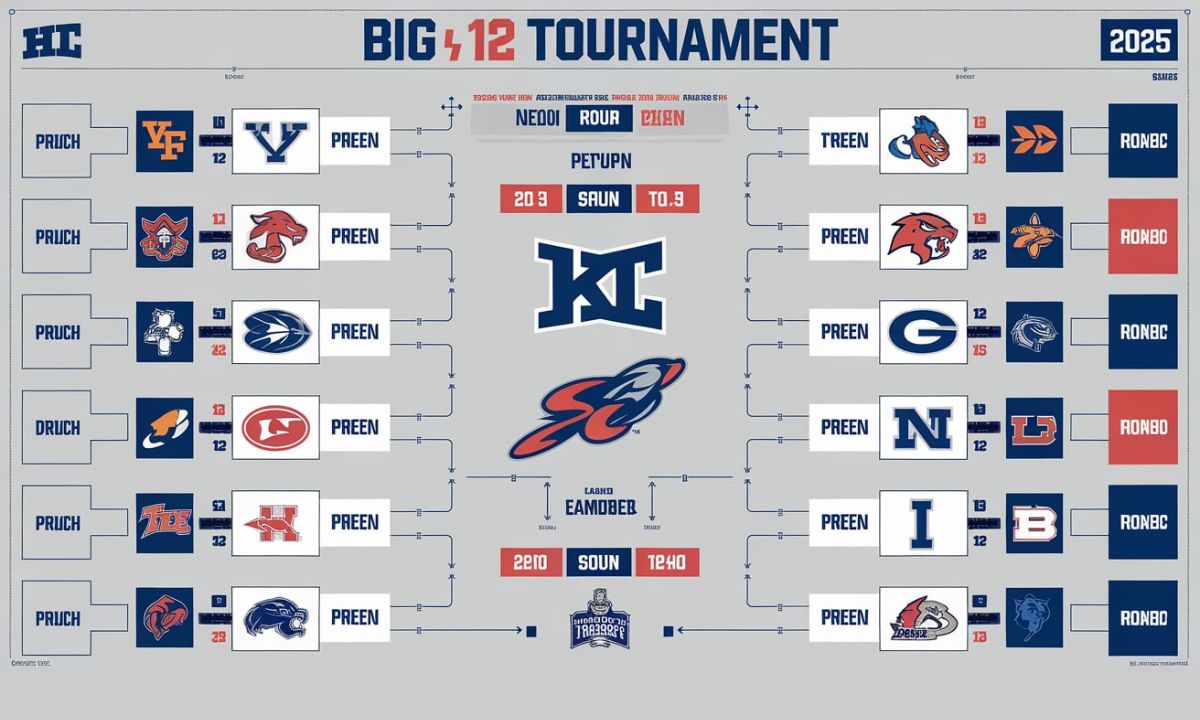As March madness approaches, college basketball fans across America are gearing up for one of the most exciting conference tournaments in the nation. The Big 12 Tournament has long been a battleground where championship dreams are realized and NCAA Tournament bids are secured.
With the conference’s expansion bringing new blood and fresh rivalries to the table, the 2025 edition promises more drama, upsets, and high-stakes basketball than ever before.
In this comprehensive guide, we’ll break down everything you need to know about the Big 12 Tournament bracket – from the format and schedule to key matchups and players to watch.
Whether you’re a die-hard fan or a casual observer looking to get in on the action, this article has you covered with all the essential information for navigating the madness of March in the Big 12.
Understanding the 2025 Big 12 Tournament Format
The 2025 Big 12 Basketball Tournament will take place from March 12-15 at the T-Mobile Center in Kansas City, Missouri – a venue that’s become synonymous with Big 12 basketball excellence. Following the conference’s expansion to 16 teams, the tournament format has evolved significantly from previous years.
All 16 teams now qualify for the tournament, with seeding determined by regular-season conference records. The top seeds receive crucial byes, giving them a significant advantage on the path to the championship:
- Seeds 1-4: Double bye (begin play in quarterfinals)
- Seeds 5-8: Single bye (begin play in second round)
- Seeds 9-16: No bye (begin play in first round)
In case of identical conference records, tiebreakers are determined by:
- Head-to-head results
- Record against the highest-seeded common opponent
- NCAA NET Rankings
Here’s a breakdown of the tournament schedule:
| Round | Date | Games | Teams |
| First Round | March 12 | 4 games | Seeds 9-16 |
| Second Round | March 13 | 4 games | Seeds 5-8 + First Round winners |
| Quarterfinals | March 14 | 4 games | Seeds 1-4 + Second Round winners |
| Semifinals | March 15 (afternoon) | 2 games | Quarterfinal winners |
| Championship | March 15 (evening) | 1 game | Semifinal winners |
This format creates tremendous pressure on lower-seeded teams, who must win five games in four days to claim the title, while the top seeds need only three victories to become champions.
Complete 2025 Big 12 Tournament Bracket Breakdown
Top Seeds and Championship Favorites
The race for the top spots in the Big 12 Tournament bracket has been fierce this season. Houston has emerged as the team to beat, claiming the regular season title in just their second year in the conference. The Cougars’ suffocating defense and efficient offense have made them a nightmare matchup for opponents. Kansas, despite some midseason struggles, has secured the second seed thanks to their trademark resilience and home-court dominance at Allen Fieldhouse.
Baylor and Iowa State round out the top four seeds, each bringing unique strengths to the table. The Bears’ guard-heavy attack has terrorized defenses all season, while the Cyclones have relied on their physical defense and rebounding prowess to grind out victories.
“This might be the deepest the Big 12 has ever been. On any given night, any team in this conference can beat anyone else. That’s what makes the tournament so unpredictable and exciting.” – Bill Self, Kansas Head Coach
Middle Bracket Matchups and Potential Upsets
Seeds 5-8 – Texas Tech, BYU, Cincinnati, and TCU – represent the dangerous middle tier of the Big 12 Basketball Tournament. These teams have shown flashes of brilliance throughout the season but lacked the consistency to claim a top spot.
Texas Tech might be the most dangerous team in this group. The Red Raiders have beaten every top-4 team at least once this season and possess the defensive intensity to frustrate even the most potent offenses. Their potential quarterfinal matchup with Kansas would be a rematch of a dramatic overtime thriller from February.
BYU has been the conference’s most pleasant surprise in their debut Big 12 season. The Cougars’ three-point shooting prowess makes them capable of catching fire and knocking off anyone in the bracket.
Bubble Teams Fighting for NCAA Tournament Bids
The expanded Big 12 features several teams hovering on the NCAA Tournament bubble, making their performance in the conference tournament potentially season-defining:
- Oklahoma State (9 seed) – The Cowboys need at least two wins to have a chance at an at-large bid
- West Virginia (10 seed) – New coach Darris Nichols has the Mountaineers playing their best basketball at the right time
- UCF (11 seed) – The Knights’ impressive non-conference resume keeps them in the conversation despite conference struggles
- Kansas State (12 seed) – Last year’s Elite Eight team needs a miracle run to return to the Big Dance
For these teams, the Big 12 Tournament represents their final opportunity to impress the selection committee and secure a spot in March Madness.
Dark Horse Contenders in the Big 12 Bracket
While attention naturally gravitates toward the top seeds, several lower-seeded teams have the potential to make deep runs:
- Oklahoma (8 seed) – The Sooners have been inconsistent but boast wins over every top-5 team
- Texas (7 seed) – New coach Rodney Terry has the Longhorns playing their best basketball in February
- Arizona (13 seed) – Despite their seeding, the Wildcats’ talent level makes them dangerous in a single-elimination format
These teams exemplify the extraordinary depth of the Big 12 Men’s Basketball Tournament, where the difference between the top and bottom teams has never been smaller.
Key Players to Watch in the Big 12 Tournament Bracket
All-Conference Stars Leading Their Teams
The Big 12 Tournament will showcase some of the nation’s most electric talents, headlined by these All-Conference performers:
- Mark Armstrong (Houston) – The junior guard leads the Cougars in scoring (18.7 PPG) and has developed into one of the nation’s premier two-way players
- Hunter Dickinson (Kansas) – The 7-foot-1 center averages a double-double (17.3 PPG, 10.2 RPG) and gives the Jayhawks a dominant interior presence
- Norchad Omier (Baylor) – The transfer from Miami has been a revelation, averaging 16.9 points and 9.8 rebounds while shooting 58% from the field
- Tamin Lipsey (Iowa State) – The Cyclones’ floor general leads the conference in assists (6.8 APG) and steals (2.7 SPG)
Breakout Performers Making Their Mark
Several players have elevated their games significantly this season and could use the Big 12 Basketball Tournament as their coming-out party:
- Pop Isaacs (Texas Tech) – The sophomore guard has nearly doubled his scoring average from last season (10.5 to 19.7 PPG)
- Dalton Knecht (Cincinnati) – The transfer from Tennessee has been a scoring machine, lighting up opponents for 22.1 PPG
- Jaxson Robinson (BYU) – The Arkansas transfer has become one of the conference’s most lethal three-point shooters (42.5%)
Impact Players Returning from Injury
Several teams will receive timely boosts from returning players:
- Kevin McCullar Jr. (Kansas) – The senior wing missed six late-season games but provides elite perimeter defense when healthy
- Emanuel Sharp (Houston) – The Cougars’ second-leading scorer returned in late February after missing three weeks
- RayJ Dennis (Baylor) – The Bears’ point guard has been battling a nagging ankle injury but appears ready for tournament play
These comebacks could dramatically alter the complexion of the Big 12 Tournament bracket and provide their teams with fresh legs at the perfect time.
Historical Big 12 Tournament Bracket Trends and Records
Past Champions and Their Paths to Victory
The Big 12 Basketball Tournament has a rich history dating back to 1997. Kansas has dominated the tournament with 12 championships, followed by Iowa State (5), Oklahoma (3), and Texas (1).
Interestingly, the #1 seed has won the tournament only 52% of the time, highlighting the unpredictable nature of the event. In fact, since 2015, a team seeded lower than #3 has reached the championship game six times.
A look at the last five champions reveals diverse paths to the title:
| Year | Champion | Seed | Notable Victories |
| 2024 | Iowa State | #2 | Def. #1 Houston in semis, #5 BYU in final |
| 2023 | Texas | #2 | Def. #3 Kansas in final |
| 2022 | Kansas | #1 | Def. #2 Baylor in semis, #3 Texas Tech in final |
| 2021 | Texas | #3 | Def. #2 Kansas in semis, #5 Oklahoma State in final |
| 2020 | Cancelled (COVID-19) | – | – |
Notable Upsets in Big 12 Tournament History
The Big 12 Tournament has delivered some shocking upsets over the years:
- 2019: #10 West Virginia defeated #2 Texas Tech in the semifinals
- 2017: #8 TCU knocked off #1 Kansas in the quarterfinals
- 2009: #9 Baylor made a stunning run to the championship game
- 2005: #12 Missouri defeated #5 Oklahoma in the first round
These upsets demonstrate why fans should expect the unexpected in Kansas City, where conference familiarity and the pressure of win-or-go-home basketball can level the playing field considerably.
Statistical Trends from Previous Tournaments
Analysis of past Big 12 Tournament data reveals several interesting patterns:
- Teams shooting over 37% from three-point range have won 76% of tournament games since 2018
- Teams with a positive assist-to-turnover ratio win approximately 68% of their games
- The team with more bench points has won 59% of tournament games
- Teams shooting more free throws win approximately 71% of their games
These statistics highlight the importance of perimeter shooting, ball security, depth, and getting to the free-throw line in tournament play.
Big 12 Basketball Standings
The final Big 12 Basketball standings determine the seeding for the tournament bracket and offer valuable context for understanding potential matchups. Here’s how the 16 teams finished the regular season:
| Seed | Team | Conference Record | Overall Record |
| 1 | Houston | 15-3 | 28-3 |
| 2 | Kansas | 14-4 | 25-6 |
| 3 | Baylor | 13-5 | 24-7 |
| 4 | Iowa State | 12-6 | 23-8 |
| 5 | Texas Tech | 11-7 | 22-9 |
| 6 | BYU | 10-8 | 22-9 |
| 7 | Cincinnati | 10-8 | 19-12 |
| 8 | TCU | 9-9 | 20-11 |
| 9 | Oklahoma | 8-10 | 19-12 |
| 10 | Oklahoma State | 8-10 | 17-14 |
| 11 | West Virginia | 7-11 | 15-16 |
| 12 | UCF | 6-12 | 16-15 |
| 13 | Kansas State | 6-12 | 15-16 |
| 14 | Texas | 5-13 | 16-15 |
| 15 | Arizona | 4-14 | 13-18 |
| 16 | Utah | 2-16 | 11-20 |
These standings illustrate the competitiveness of the conference, with only seven games separating the first-place team from the ninth-place finisher. The middle of the pack is particularly congested, with seeds 7-11 separated by just two games.
How to Follow the Big 12 Tournament Bracket
The Big 12 Men’s Basketball Tournament will be broadcast across multiple networks, giving fans plenty of options for catching all the action:
- First Round: ESPN+
- Second Round: ESPN2
- Quarterfinals: ESPN/ESPN2
- Semifinals and Championship: ESPN
Streaming options include the ESPN app and ESPN+, which require a subscription or cable provider authentication. For those without cable, services like YouTube TV, Hulu + Live TV, and Sling TV will carry the tournament games.
Social media provides another excellent way to stay updated on bracket progress. Follow these accounts for real-time updates:
- Official Big 12 Conference: @Big12Conference
- ESPN College Basketball: @ESPNCBB
- CBS Sports College Basketball: @CBSSportsCBB
Pro Tip: Download the official Big 12 app for live scores, stats, and bracket updates throughout the tournament.
Big 12 Tournament Bracket Predictions
First Round Matchup Analysis
The opening round of the Big 12 Tournament bracket features four intriguing matchups:
- #9 Oklahoma vs. #16 Utah: The Sooners swept the regular-season series and should advance comfortably
- #10 Oklahoma State vs. #15 Arizona: Don’t sleep on Arizona despite their record; this could be the closest first-round game
- #11 West Virginia vs. #14 Texas: A classic Big 12 rivalry with both teams desperate to extend their seasons
- #12 UCF vs. #13 Kansas State: The Knights and Wildcats split their regular-season meetings, making this a true toss-up
Projected Quarterfinal and Semifinal Contests
Based on season-long trends and matchup advantages, here are our projected later-round matchups:
Quarterfinals:
- #1 Houston vs. #9 Oklahoma
- #4 Iowa State vs. #5 Texas Tech
- #2 Kansas vs. #10 Oklahoma State
- #3 Baylor vs. #6 BYU
Semifinals:
- #1 Houston vs. #5 Texas Tech
- #2 Kansas vs. #3 Baylor
These projections account for stylistic matchups and recent performance trends, though the unpredictable nature of the Big 12 Tournament means upsets are virtually guaranteed.
Championship Game Scenario Breakdown
Our projected championship game features a #1 Houston vs. #2 Kansas showdown. This would match the conference’s best defense (Houston) against its most efficient offense (Kansas). The teams split their regular-season meetings, with each winning on their home court.
The key factors in this potential championship matchup:
- Kansas’ ability to handle Houston’s perimeter pressure
- Houston’s offensive rebounding vs. Kansas’ size advantage
- The Dickinson-Armstrong individual matchup
- Bench production from both teams
Prediction: Houston defeats Kansas 68-65 in a defensive struggle to claim their first Big 12 Tournament championship.
Big 12 Men’s Basketball Tournament Printable Version
For fans looking to track the action or participate in bracket pools, we’ve created a printable version of the Big 12 Tournament bracket. Download your printable bracket here.
When filling out your bracket, consider these strategic tips:
- Don’t get upset-happy – While upsets happen, the top 4 seeds still win approximately 70% of tournament championships
- Consider fatigue factors – Teams playing their fourth game in four days rarely win the championship
- Evaluate momentum – Teams that won 7+ of their final 10 regular-season games have historically overperformed in the tournament
- Look for veteran leadership – Teams with experienced guards tend to perform better in tournament settings
Remember to check back for updated brackets after each round of the tournament!
Conclusion
The 2025 Big 12 Tournament bracket represents the culmination of one of the most competitive seasons in conference history. With 16 teams now battling for the automatic NCAA Tournament bid and conference bragging rights, fans can expect four days of intense, high-quality basketball.
Houston enters as the favorite, but Kansas, Baylor, and Iowa State all have legitimate championship aspirations. Meanwhile, bubble teams like Oklahoma, Oklahoma State, and West Virginia have everything to play for as they seek to secure their NCAA Tournament futures.
What makes the Big 12 Tournament so special is its unpredictability – the depth of the conference means that truly any team can make a run. Whether you’re attending in person at the T-Mobile Center or watching from home, this year’s tournament promises to deliver the drama, intensity, and excitement that college basketball fans crave in March.
Will Houston validate their regular-season title with a tournament championship? Can Kansas add to their record collection of tournament trophies? Or will a dark horse emerge from the pack to shock the basketball world? The answers await as the Big 12 Basketball Tournament tips off on March 12!
FAQ Section
Q: When does the Big 12 Tournament start? A: The 2025 Big 12 Tournament begins on Wednesday, March 12, with first-round games and concludes with the championship game on Saturday, March 15.
Q: Where is the 2025 Big 12 Tournament being held? A: The tournament will take place at the T-Mobile Center in Kansas City, Missouri.
Q: How many teams qualify for the Big 12 Tournament bracket? A: All 16 teams in the expanded Big 12 Conference qualify for the tournament.
Q: Which team has won the most Big 12 Tournament championships? A: Kansas has won the most with 12 tournament championships, followed by Iowa State with 5.
Q: How does the Big 12 Tournament bracket impact NCAA Tournament selection? A: The tournament champion receives an automatic bid to the NCAA Tournament. For bubble teams, making a deep run can significantly improve their chances of receiving an at-large bid.










